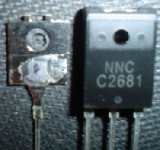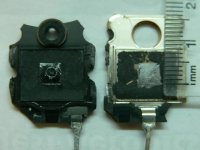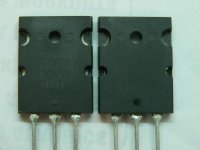sbrook said:Look at the *difference* in those heatsinks!
The ones to the right, with the stamp can't be flat on the back! and look at the irregular top of the heatsink. They SCREAM FAKE!
I agree at 100%
but I don't understand from where all these false bjts come

Like where did this melamine tainted gluten that found its way into pet food come from?
From small to medium size companies in countries with little to no care for who they rip off and are desperate for western currencies.
Goodness knows it's easy enough to do ... get some metal to fabricate a heatsink, buy cheap transistors to put inside the case so the leads show something like correct characteristics then pot them in epoxy and paint the numbers on.
Then you sell them through middle men who will take the fall. Or sell them through things like ebay (sadly, while ebay is brilliant, it's also a terrific way to market knock off products). If a large electronics distributor has need of particular components and he sees a supply available, he'll buy to meet that need, not always checking quality or source. Of course, if he asks for samples, they'll send a few of the "real thing".
From small to medium size companies in countries with little to no care for who they rip off and are desperate for western currencies.
Goodness knows it's easy enough to do ... get some metal to fabricate a heatsink, buy cheap transistors to put inside the case so the leads show something like correct characteristics then pot them in epoxy and paint the numbers on.
Then you sell them through middle men who will take the fall. Or sell them through things like ebay (sadly, while ebay is brilliant, it's also a terrific way to market knock off products). If a large electronics distributor has need of particular components and he sees a supply available, he'll buy to meet that need, not always checking quality or source. Of course, if he asks for samples, they'll send a few of the "real thing".
anatech said:Hi Pete,
I am currently (very slowly) playing with a couple SymAsym boards. They sound really good, and are overkill for what I wanted and expected. So overkill it is!
We must thank Mike and Pavel who developed this amp, and Carlos who started the first thread. If you get a chance you should zap a couple together.
-Chris
Hi Chris,
Just wondering for the SymAsym, which hfe range do you think is best, I think they'd all probably work fine (matched P to N of course), but do you have a preference:
Sanken hfe codes: O(50 to 100) P(70 to 140) Y(90 to 180)
Pete B.
Hi Pete,
I used MJW0281A and MJW0302A. All of the transistors measured hFE close to 100. That's for NPN and PNP! Other transistors I checked had hFE ranges further spread apart and measured higher in THD. I was also able to run these at lower bias currents than normal. All the other transistors were as the BOM, but matched and thermally coupled.
You can match your outputs close I know, but getting PNP and NPN's to come close is much more difficult. I did try some other types but kept coming back to the On Semi devices.
I wouldn't mind trying this with some other Japanese numbers, but my selection these days is both suspect and very limited. I haven't had a chance to go through your list very well due to a number of things. It's not due to a lack of interest on my part.
I am also in the process of completely revamping my work space and will have higher capabilities when I'm done. That is soaking up a fair amount of time.
-Chris
I used MJW0281A and MJW0302A. All of the transistors measured hFE close to 100. That's for NPN and PNP! Other transistors I checked had hFE ranges further spread apart and measured higher in THD. I was also able to run these at lower bias currents than normal. All the other transistors were as the BOM, but matched and thermally coupled.
You can match your outputs close I know, but getting PNP and NPN's to come close is much more difficult. I did try some other types but kept coming back to the On Semi devices.
I wouldn't mind trying this with some other Japanese numbers, but my selection these days is both suspect and very limited. I haven't had a chance to go through your list very well due to a number of things. It's not due to a lack of interest on my part.
I am also in the process of completely revamping my work space and will have higher capabilities when I'm done. That is soaking up a fair amount of time.
-Chris
anatech said:Hi Pete,
I used MJW0281A and MJW0302A. All of the transistors measured hFE close to 100. That's for NPN and PNP! Other transistors I checked had hFE ranges further spread apart and measured higher in THD. I was also able to run these at lower bias currents than normal. All the other transistors were as the BOM, but matched and thermally coupled.
You can match your outputs close I know, but getting PNP and NPN's to come close is much more difficult. I did try some other types but kept coming back to the On Semi devices.
I wouldn't mind trying this with some other Japanese numbers, but my selection these days is both suspect and very limited. I haven't had a chance to go through your list very well due to a number of things. It's not due to a lack of interest on my part.
I am also in the process of completely revamping my work space and will have higher capabilities when I'm done. That is soaking up a fair amount of time.
-Chris
Those are rated for 75 to 150 so it seems they'd be similar to the mid grade Sankens. Thanks, was just curious.
Pete B.
Hi Pete,
With tolerances this close I immediately fell in love with these parts ... well not quite true. After some testing and listening they became a clear choice for me.
-Chris
Forget the rating. Every single one was very close. I think I had a flyer or two sitting at 105. No kidding.Those are rated for 75 to 150
With tolerances this close I immediately fell in love with these parts ... well not quite true. After some testing and listening they became a clear choice for me.
-Chris
Anyone ever seen these, or heard of the brand ?
The number is supposed to be an NEC(ETC), became obsolete in 2002.
I also got a bunch of the 2SA partner from a different source, but those do read NEC.
These devices are supposed to have a 100 watt rating and an Ft of 80/90 MHz.
The capacitances measure ok but it has an insulated casing, similar to TO-126 and some TO-220 Sanyo devices.
Haven't put one through Eva's full force test yet.
Speaking of which, i hope "La Mejor" de la alta energia conmutation occasionally reads this thread.
Fred says : Evaaaaaaaa !!
The number is supposed to be an NEC(ETC), became obsolete in 2002.
I also got a bunch of the 2SA partner from a different source, but those do read NEC.
These devices are supposed to have a 100 watt rating and an Ft of 80/90 MHz.
The capacitances measure ok but it has an insulated casing, similar to TO-126 and some TO-220 Sanyo devices.
Haven't put one through Eva's full force test yet.
Speaking of which, i hope "La Mejor" de la alta energia conmutation occasionally reads this thread.
Fred says : Evaaaaaaaa !!
Attachments
I'm a bit of a brute, i opened the case with a nutcracker.
Touching a wine glas has been a no-no for like 25 years, i can torque the thread off the most incredible size hexagonal nuts though. First time i'm opening up a transistor.
One half of the die is left on the epoxy that cracked off, the triangular patch is part of the intermediate layer of the die.
The die measures a wee over 4mm x4mm, measured the metal bonding plate by hand and the die from an enlarged digital pic.
Also the first time i see a fully insulated device of this size.
Touching a wine glas has been a no-no for like 25 years, i can torque the thread off the most incredible size hexagonal nuts though. First time i'm opening up a transistor.
One half of the die is left on the epoxy that cracked off, the triangular patch is part of the intermediate layer of the die.
The die measures a wee over 4mm x4mm, measured the metal bonding plate by hand and the die from an enlarged digital pic.
Also the first time i see a fully insulated device of this size.
Hello, I recently bought 2 pairs of 2SC5200 & 2SA1900 in
Bangalore for Rs.180 (about US$4.30 ).
After checking this forum, I intially thought they
were fake on account of the price , but after opening
one of them, measuring their Hfe and Cbc, Cbe I think
that they may just be genuine indeed.
Can anyone please help me figure if they are real or
fake - I am mighty tempted to revisit the shop and
stock up.
2SC5200:
Cbe = 5.76nF, Cbc = 0.65nF
Ic (Amps) Hfe
---------------------------
0.0486 108
0.1698 115
0.2049 115
0.375 121
0.555 125
0.7425 126
1.02 128
1.254 127
2SA1943
Cbe = 5nF, Cbc = 1.153nF
Ic (Amps) Hfe
---------------------------
0.0522 116
0.1011 125
0.2124 119
0.555 125
0.825 124
1.119 123
1.242 120
The Cap values were taken on my DMM. Not sure of the applied AC voltage or frequency during measurement. The Hfe curve seems to fmatch the datasheet but I could not test above Ic = 1.2A on account of my power supply.
Here are the pics of the opened 2SC5200. The die is just under 5mmx5mm and looks similar to the original one shown on
http://www.yoreparo.com/articulos/electronica/transistores-falsificados_2.html
(Search for "transistores 2SA1943 y 2SC5200" on the page)
Cheers,
Santhosh
Bangalore for Rs.180 (about US$4.30 ).
After checking this forum, I intially thought they
were fake on account of the price , but after opening
one of them, measuring their Hfe and Cbc, Cbe I think
that they may just be genuine indeed.

Can anyone please help me figure if they are real or
fake - I am mighty tempted to revisit the shop and
stock up.
2SC5200:
Cbe = 5.76nF, Cbc = 0.65nF
Ic (Amps) Hfe
---------------------------
0.0486 108
0.1698 115
0.2049 115
0.375 121
0.555 125
0.7425 126
1.02 128
1.254 127
2SA1943
Cbe = 5nF, Cbc = 1.153nF
Ic (Amps) Hfe
---------------------------
0.0522 116
0.1011 125
0.2124 119
0.555 125
0.825 124
1.119 123
1.242 120
The Cap values were taken on my DMM. Not sure of the applied AC voltage or frequency during measurement. The Hfe curve seems to fmatch the datasheet but I could not test above Ic = 1.2A on account of my power supply.
Here are the pics of the opened 2SC5200. The die is just under 5mmx5mm and looks similar to the original one shown on
http://www.yoreparo.com/articulos/electronica/transistores-falsificados_2.html
(Search for "transistores 2SA1943 y 2SC5200" on the page)
Cheers,
Santhosh
Attachments
Hi,
an electrical test to destruction would have been more informative.
1.0A into a medium heatsink and ramp up the Vce voltage, waiting for thermal stabilty and see how far into second breakdown the device could survive. Final temp measurement would allow comparison to the de-rated DC SOA. But too late.
an electrical test to destruction would have been more informative.
1.0A into a medium heatsink and ramp up the Vce voltage, waiting for thermal stabilty and see how far into second breakdown the device could survive. Final temp measurement would allow comparison to the de-rated DC SOA. But too late.
That's a neat idea. Would have tried it on one of the remaining pieces I don't have the right thermometer.
I was hoping that the Hfe values and the fact that it had a 5x5mm die could be used as an indicator. I don't think that a fake die of this size would show the kind of gain and linearity that I saw.
As a reference point, 2N3055 has a Hfe of about 90 at 1A.
Here are a few more pics of the devices
Regards,
Santhosh
I was hoping that the Hfe values and the fact that it had a 5x5mm die could be used as an indicator. I don't think that a fake die of this size would show the kind of gain and linearity that I saw.
As a reference point, 2N3055 has a Hfe of about 90 at 1A.
Here are a few more pics of the devices
Regards,
Santhosh
Attachments
Well, one things for sure, with a 5mm square die, it WAS a power transistor die, and given that the idea behind the fakes is to make money by putting in the cheapest die they can get away with to show transistor characteristics with a fast check on a DVM, it wouldn't make sense to put in a power transistor die.
So, my bet would therefore be that it is probably genuine.
Find the transistor's hfe curves and if they are in the same ballpark as the values you pulled, then it's even more probably genuine.
For power transistors, look at some of the earlier examples in this thread ... the heatsink isn't cut cleanly and isn't ground flat ... two sure signs of a fake.
So, my bet would therefore be that it is probably genuine.
Find the transistor's hfe curves and if they are in the same ballpark as the values you pulled, then it's even more probably genuine.
For power transistors, look at some of the earlier examples in this thread ... the heatsink isn't cut cleanly and isn't ground flat ... two sure signs of a fake.
sant_ka said:Yes, that's what I guessed as well. The Hfe values tally with the spec and the devices pass the cosmetic checks ( heatsink flatness etc).
Was just wondering if there was anything other obvious criteria/observation that I missed.
Regards,
Santhosh
Can you let me know address of the shop selling these items?
Regards
Ashwick
- Home
- Design & Build
- Parts
- My Transistors, original or copy?



